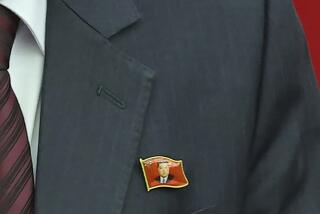North Korea Workers’ Party meeting raises speculation
- Share via
Reporting from Seoul — For a confab with such far-reaching implications, not much is known about North Korea’s largest political gathering in three decades, rumored to be staged in the capital of Pyongyang this week.
The time frame for the Workers’ Party meetings, released by officials, was simply “early September,” leading North Korea watchers to speculate that the events would kick off Monday, the country’s founding day.
As for the would-be guest of honor — North Korean leader Kim Jong Il’s youngest son, Kim Jong Eun, who is expected to assume the reins of power from his ailing father — well, few people can even say what he looks like because there are no confirmed photos of him and he has never been seen in public.
For weeks, the regime has rolled out a propaganda campaign, including songs and poems, praising the younger Kim. Then, on Sunday, the state-run media stopped reporting on the event, imposing a news blackout that many observers speculate will be in place for the duration of the convention.
Such is the reality of the secretive nation known by outsiders as the Hermit Kingdom, stubbornly resisting the world’s prying eyes.
Still, analysts and South Korean intelligence sources expect significant results from the first major party gathering since 1980, when Kim Jong Il was named to succeed his father, Kim Il Sung, who died of a heart attack in 1994.
Kim Jong Il, 68, who is reportedly partially paralyzed since suffering a stroke in 2008, is expected to name his youngest son to a key party post that will signal an imminent transfer of power.
On Sunday, China’s official New China News Agency ran photographs showing several thousand North Koreans gathering in Pyongyang’s main Kim Il Sung square, presumably to rehearse for the party celebration. The agency said the preparations were cut short by rain.
Experts say Kim Jong Eun, believed to have been born in late 1983 or early 1984, may be publicly introduced to the nation.
“This is an unusual event — nothing like this has happened for decades,” said Andrei Lankov, a professor of history at Kookmin University in Seoul who has written extensively on North Korea.
Experts are divided on the speed with which Kim Jong Eun could assume power. Some believe he will be appointed to the same party post his father took decades ago, a key post in charge of supervising party members and appointing top officials. After that, he will be named supreme commander of North Korea’s 1.2 million-member army and, later, general secretary of the Workers’ Party.
Others say the younger Kim’s rise will come more slowly and that he still has to be groomed to run state affairs.
“Given that Kim Jong Eun is only in his late 20s or early 30s, there’s a good chance that he will be given a limited working-level title during this meeting,” said Kim Yong-hyun, professor of North Korean studies at Dongguk University in Seoul.
Analysts also disagree on the future role to be played by Kim Jong Il. Will he semi-retire to receive medical treatment or remain the regime’s public face for years to come?
“More likely, though, is that the young Kim will remain a figurehead for years. He is way too young and inexperienced, so he would be extolled and allowed to sign papers, but those papers will be drafted by the same people who are drafting papers now. So, in all probability, there will be no change in the short term.”
Kim Jong Il has just returned from a secretive five-day trip to China, where he met with Chinese President Hu Jintao about further aid to develop North Korea’s ailing economy and about Kim’s intentions to rejoin the stalled six-party talks aimed at dismantling North Korea’s nuclear arsenal.
The trip was also believed to be aimed at strengthening ties with China during North Korea’s fragile transition of power. Analysts theorized that the younger Kim accompanied his father on the trip, but his presence was not confirmed.
Experts predict that even with a new figurehead, the government in Pyongyang is unlikely to make any major changes in its international stance.
As with other major events in North Korea, the Workers’ Party meetings will be conducted behind closed doors. Analysts say the sessions could last a few days to as long as three weeks.
Ethan Kim in the Times’ Seoul bureau contributed to this report.
More to Read
Sign up for Essential California
The most important California stories and recommendations in your inbox every morning.
You may occasionally receive promotional content from the Los Angeles Times.














